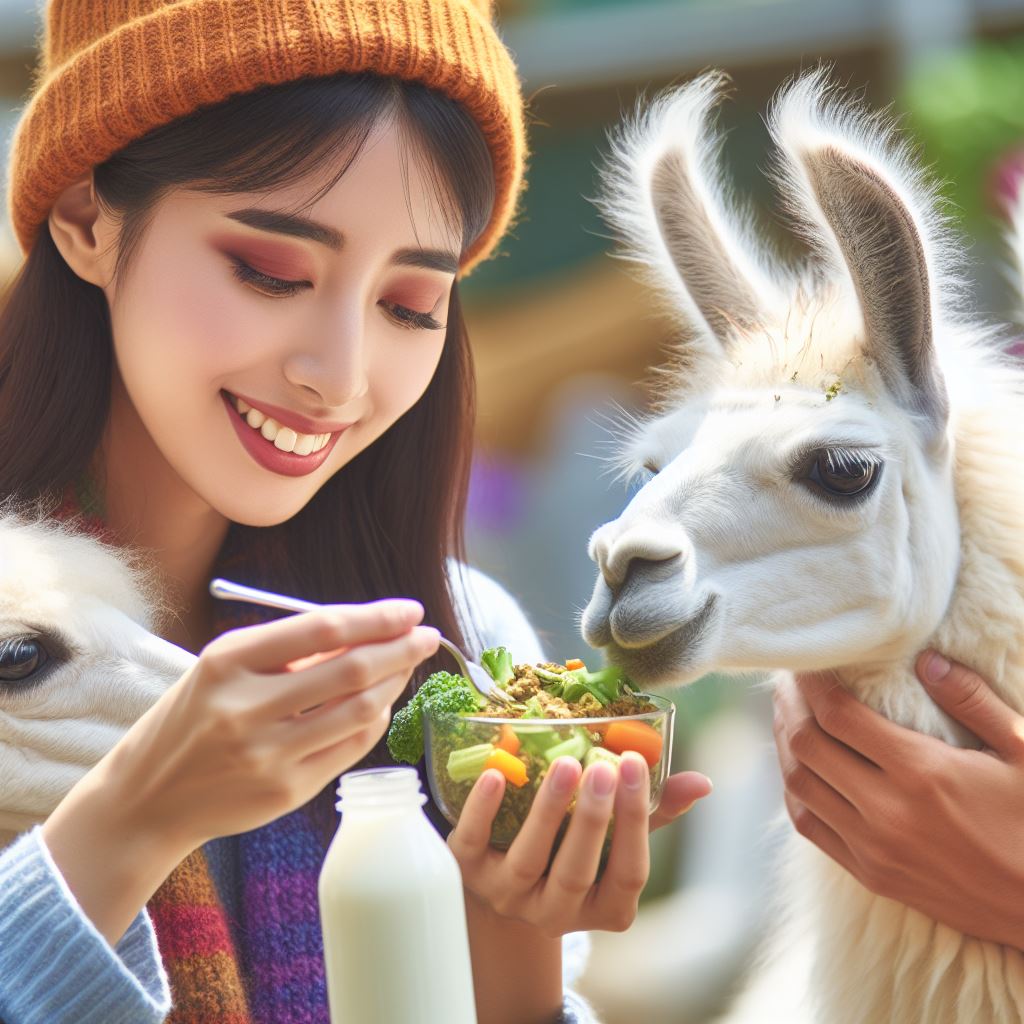Llama Feeding Basics: Health & Nutrition Tips
Last Updated on January 25, 2024
Introduction
Briefly introduce the topic of Llama feeding basics
Let’s Explore Llama Feeding Basics: Health & Nutrition Tips
Maintaining the health and nutrition of llamas is of utmost importance to ensure their optimal well-being.
Llama feeding basics encompass a wide range of factors that directly impact their health, growth, and overall development.
This section aims to provide a comprehensive overview of the essential aspects related to the feeding practices of llamas.
Importance of health and nutrition in llama care
Proper nutrition plays a significant role in promoting optimal health in llamas.
These unique creatures have specific dietary requirements that must be met for their overall well-being.
Providing them with a balanced and nutritious diet is crucial in preventing nutritional deficiencies, promoting growth, and improving their immune system.
It is essential to understand that llamas are herbivores and have a delicate digestive system.
They primarily feed on grass, hay, and other plant materials.
Feeding them a diet rich in fiber is vital to prevent digestive issues such as bloating and colic.
Additionally, llamas must have access to clean, fresh water at all times to maintain hydration.
Furthermore, maintaining their health goes beyond just their diet.
Regular veterinary check-ups, vaccinations, and parasite control are essential for their overall well-being.
Implementing a proper vaccination schedule and deworming regimen is crucial in preventing the risk of diseases and parasitic infections.
Therefore, proper health and nutrition practices are fundamental in ensuring the longevity and happiness of llamas.
Understanding the basics of llama feeding and prioritizing their health needs will allow these unique animals to thrive in their environment.
By providing them with optimal nutrition and healthcare, we can ensure that llamas lead healthy and fulfilling lives.
Health Tips for Llamas
Regular veterinary check-ups and vaccinations
- Ensure that your llamas have regular check-ups with a qualified veterinarian.
- Vaccinations are essential to prevent diseases such as tetanus, rabies, and footrot.
- Follow the vaccination schedule recommended by the veterinarian to maximize protection.
- Regular check-ups allow early detection of any potential health issues and prompt treatment.
- Consult your vet about any specific health concerns or questions you may have regarding your llamas.
Proper grooming and hygiene practices
- Regularly groom your llamas to keep their coat clean and free of tangles or mats.
- This helps prevent skin problems and allows better temperature regulation.
- Brushing also promotes blood circulation, leading to healthier and more lustrous fur.
- Inspect and clean their ears, eyes, and teeth regularly to avoid infections and dental issues.
- Hoof care is crucial; trim the hooves regularly to prevent lameness and discomfort.
Preventing and treating common illnesses and parasites
- Implement a comprehensive parasite control program recommended by your vet.
- Regularly deworm your llamas to prevent internal parasites and their associated health issues.
- Be vigilant for external parasites like ticks and lice; treat infestations promptly.
- Keep your llamas’ living area clean and provide adequate ventilation to prevent respiratory problems.
- Ensure a balanced diet with appropriate minerals and vitamins to maintain optimal health.
Regular veterinary check-ups, vaccinations, proper grooming, and hygiene practices, as well as preventing and treating common illnesses and parasites, are vital for maintaining the health and well-being of your llamas.
By following these recommended practices and seeking professional advice, you can provide your llamas with the best care possible.
Remember, happy and healthy llamas are the key to a successful and rewarding llama-keeping experience.
Read: Buffalo Feeding Guide for Better Meat Quality

Nutrition Tips for Llamas
Proper nutrition is paramount to maintaining the overall health and well-being of llamas.
Understanding their dietary needs and providing a balanced and nutritious diet is essential.
This section will explore various nutrition tips to ensure llamas receive optimal nutrition for their overall health.
Understanding the dietary needs of llamas
Llamas are herbivores, and their diet primarily consists of fiber-rich vegetation.
They have a unique digestive system that allows them to efficiently process and utilize nutrients from plant material.
Providing a balanced and nutritious diet
A well-balanced diet for llamas should consist of the following components:
- Hay and pasture as the main sources of fiber
- Supplementing with specialized llama feed, if necessary
Introducing dietary changes gradually
Llamas have sensitive digestive systems, and sudden dietary changes can lead to digestive upsets.
When introducing new foods or altering their diet, it is crucial to do so gradually over a period of several days or weeks.
Monitoring llamas’ water intake
Adequate water intake is crucial for llamas to maintain proper hydration, digestion, and overall health.
It is important to monitor their water sources regularly and ensure they have access to clean and fresh water at all times.
By understanding the dietary needs of llamas and providing a balanced and nutritious diet, you can help ensure their overall well-being.
Gradual dietary changes and monitoring their water intake are also essential for maintaining optimal health. Remember, a healthy diet is key to keeping your llamas happy and thriving.
Read: Deer Farming Feed Strategies for Growth & Health
Feeding Schedule for Llamas
Feeding llamas should not be taken lightly, as it directly impacts their overall health and well-being.
By following a proper feeding schedule, llama owners can ensure their animals receive the right quantity of food, divided into smaller portions, and given at consistent times.
Determining the appropriate quantity of food
Determining the appropriate quantity of food is essential to meet a llama’s nutritional needs.
Age, weight, and activity level are crucial factors to consider when assessing the right amount of food to provide.
Consulting with a veterinarian or experienced llama breeder can provide valuable insights and specific recommendations tailored to individual llamas.
Monitoring the llama’s body condition score on an ongoing basis is crucial. It helps to ensure the llama is neither underweight nor overweight.
Adjustments to the feeding quantity may be necessary depending on physical changes and weight fluctuations.
Dividing the meals into smaller and frequent portions
Dividing meals into smaller and more frequent portions is advantageous for llamas.
It promotes better digestion and prevents overeating.
Splitting the daily food allowance into two or three meals is ideal.
Feeding llamas separately in designated areas ensures fair distribution and proper intake for each animal.
Using slow-feeders or hay nets during mealtime extends the feeding duration, mimicking llamas’ natural grazing behavior.
This practice can help prevent boredom and alleviate potential behavioral issues.
It also allows the llamas to consume food at a slower pace, promoting healthier digestion.
Observing the llamas while they eat is crucial to ensure they are not facing any difficulties or choking hazards.
Any signs of discomfort or abnormal behavior should be addressed promptly.
Adjustments to the feeding routine or veterinary assistance may be required to address potential concerns.
Consistency in feeding times
Maintaining consistency in feeding times is essential.
Establishing a regular feeding schedule helps llamas anticipate meal times, reducing stress and anxiety.
Consistency also aids in maintaining a regular eating pattern, contributing to overall digestive health.
Sudden changes in feeding times should be avoided.
Abrupt alterations can cause stress and disrupt the llama’s digestive system.
If adjustments to the schedule are necessary, they should be made gradually, allowing the llamas to adapt and avoid any adverse effects.
Providing llamas with access to fresh water is crucial during feeding periods.
Hydration is essential for proper digestion and overall health.
Clean water should be available at all times to ensure the llamas remain adequately hydrated.
In essence, a proper feeding schedule plays a vital role in maintaining the health and well-being of llamas.
Determining the appropriate quantity of food, dividing meals into smaller portions, and maintaining feeding consistency are key factors to consider.
By following these guidelines, llama owners can ensure their animals receive optimal nutrition and lead healthy lives.
Read: Swine Genetics: Boosting Pig Health & Yield
Common Feeding Problems and Solutions
Overfeeding and obesity
- Recognizing signs of overfeeding is crucial in preventing obesity in llamas.
- Adjusting the diet and exercise routines according to the needs and activity levels of llamas can help combat overfeeding and obesity.
Underfeeding and malnutrition
- Recognizing signs of underfeeding such as weight loss, lethargy, and poor coat condition is important.
- Ensuring llamas have adequate intake by providing enough food and adjusting the diet based on their nutritional requirements is essential.
Maintaining healthy weight and condition
In order to maintain a healthy weight and condition:
- Regularly monitor the llama’s body condition and weight to identify any changes.
- Adjust the diet based on the individual llama’s needs, activity level, and growth stage.
- Provide a balanced diet that includes good quality hay, fresh water, and appropriate supplements.
- Avoid excessive grazing on lush pastures, as it can lead to overweight llamas.
- Control access to feed and prevent overeating by using slow feeders or feeding small frequent meals.
- Ensure llamas have regular exercise and access to sufficient space for movement.
- Monitor the condition of llamas’ feet to ensure they can move comfortably.
- Regularly consult with a veterinarian or a nutritionist to ensure your llamas’ dietary needs are met.
- Be mindful of any changes in appetite, weight, or behavior that may indicate a problem.
- Address any feeding issues promptly to prevent long-term health problems.
By being aware of common feeding problems and implementing appropriate solutions, llama owners can ensure the health and well-being of their animals.
Maintaining proper nutrition and weight control is essential for llamas to thrive and live a long, happy life.
Read: Sheep Breeding 101: Best Genetic Practices
Conclusion
It is crucial to prioritize the health and nutrition of llamas when caring for them.
Throughout this blog post, we have discussed several key points:
- The importance of a balanced diet for llamas, consisting of hay, pellets, and fresh water.
- The significance of monitoring their weight and adjusting their diet accordingly.
- The essential vitamins and minerals llamas require, such as vitamin D and selenium.
- The potential health issues that can arise from improper nutrition, such as dental problems and obesity.
- The significance of regular veterinary check-ups to ensure their overall well-being.
By implementing these tips, you can promote optimal llama feeding and contribute to their overall well-being.
Take the necessary steps to provide a healthy and nutritious diet for your llamas, and they will thrive!


